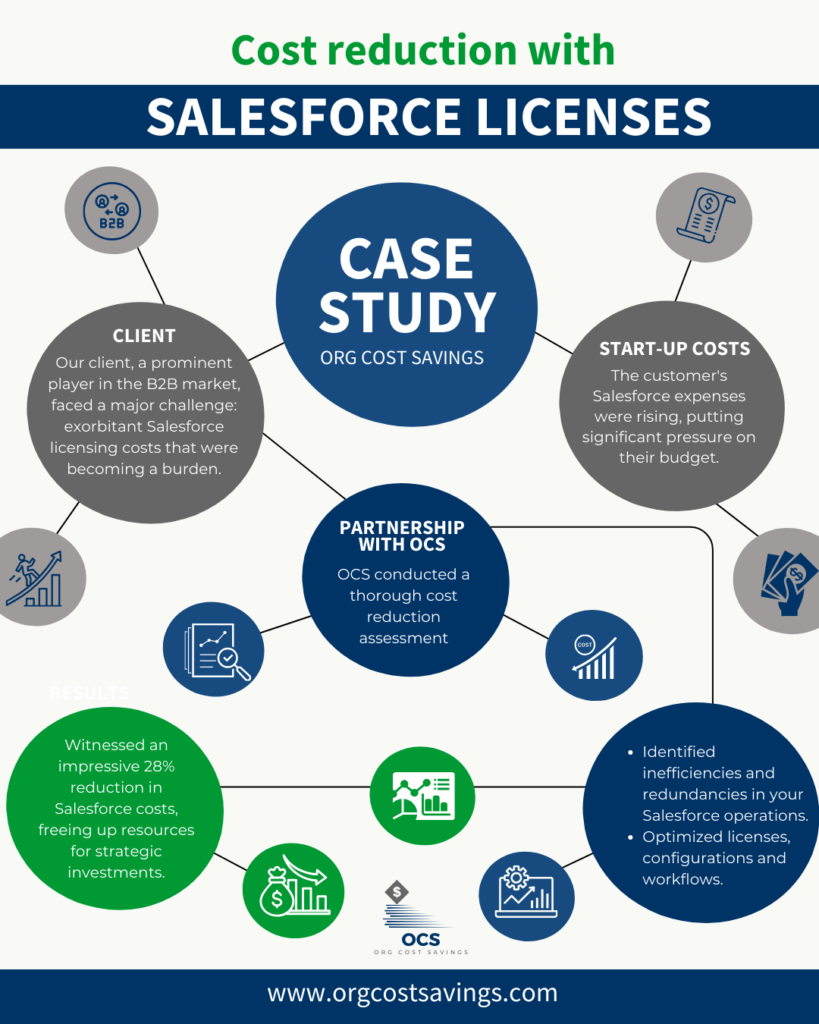In the competitive world of sales, efficiency is the key to success and when it comes to increasing sales efficiency, Salesforce Sales Cloud is the ultimate game changer.
This powerful customer relationship management (CRM) platform is designed to streamline sales processes, optimize workflows, and drive revenue growth.
In this article, we’ll explore best practices and strategies for using Salesforce Sales Cloud to improve sales performance and achieve remarkable results.
From simplifying lead management and automating repetitive tasks to providing real-time insights and fostering collaboration, Salesforce Sales Cloud offers a comprehensive solution for sales teams of all sizes.
By leveraging its advanced features and capabilities, companies can improve customer engagement, accelerate sales cycles and, ultimately, generate greater revenue.
Join us as we dive into the world of Salesforce Sales Cloud and discover strategies, tips, and tricks that can turn your sales team into a well-oiled revenue-generating machine.
Whether you’re new to Salesforce or an experienced user, this article will provide valuable insights and practical advice to help you maximize the potential of Salesforce Sales Cloud and increase your sales efficiency to new heights.
Benefits of using Salesforce Sales Cloud
Salesforce Sales Cloud offers a multitude of benefits for companies looking to improve their sales efficiency.
Firstly, it provides a centralized platform for managing leads and opportunities, allowing sales teams to easily track and prioritize their activities.
With real-time visibility into the sales pipeline, sales reps can focus their efforts on high-value prospects, increasing their chances of closing deals.
Additionally, SSC enables sales automation, reducing time spent on repetitive tasks and administrative work.
By automating processes like contact management, opportunity tracking, and quote generation, sales teams can allocate more time to building customer relationships and closing deals.
Additionally, SSC offers advanced analytics and reporting capabilities, providing sales leaders with valuable insights into team performance, customer behavior and sales trends.
By leveraging these insights, companies can make data-driven decisions, identify areas for improvement, and optimize their sales strategies.
Best practices for implementing Salesforce Sales Cloud
While Salesforce Sales Cloud offers a range of powerful features, successful implementation requires careful planning and execution. Here are some best practices to consider when implementing Salesforce Sales Cloud:
- 1. Define clear goals and objectives: Before implementing Salesforce Sales Cloud, it is important to clearly define your sales objectives and align them with the capabilities of the platform. This will ensure that you are leveraging Salesforce Sales Cloud to its full potential and driving the desired outcomes.
- 2. Involve key stakeholders: Involving key stakeholders from various departments, such as sales, marketing, and IT, is crucial for a successful implementation. This will help ensure that everyone’s needs and requirements are taken into account, and that the platform is configured to support the overall business strategy.
- 3. Invest in training and support: Providing comprehensive training and ongoing support to your sales team is essential for successful adoption of Salesforce Sales Cloud. This will enable them to fully utilize the platform’s features and capabilities, leading to increased sales efficiency.
- 4. Customize and optimize: Salesforce Sales Cloud offers a high level of customization, allowing businesses to tailor the platform to their specific needs. Take the time to configure the system according to your sales processes and workflows, and continuously optimize it as your business evolves.
- 5. Monitor and measure: Regularly monitor and measure the impact of SSC on your sales performance. This will allow you to identify areas for improvement, make data-driven decisions, and drive continuous sales efficiency gains.
Strategies for maximizing sales efficiency using Salesforce Sales Cloud

To truly maximize sales efficiency with Salesforce Sales Cloud, businesses can implement a range of strategies. Here are some effective strategies to consider:
- 1. Streamline lead management: Implement lead scoring and routing rules to ensure that leads are assigned to the most qualified sales representatives. Leverage automation to capture, qualify, and assign leads efficiently, reducing manual effort and increasing conversion rates.
- 2. Automate repetitive tasks: Identify repetitive tasks within your sales processes and automate them using SSC. By automating activities such as data entry, follow-ups, and quote generation, sales representatives can focus on high-value activities that drive revenue.
- 3. Leverage real-time insights: Utilize the powerful analytics and reporting capabilities of SSC to gain real-time insights into sales performance, customer behavior, and market trends. Use these insights to identify areas for improvement, optimize sales strategies, and make data-driven decisions.
- 4. Foster collaboration: Encourage collaboration among sales team members by leveraging Salesforce Sales Cloud’s collaboration tools, such as Chatter. Enable seamless communication, information sharing, and deal collaboration, ensuring that everyone is aligned towards achieving sales targets.
- 5. Enable mobile sales: Empower your sales team with mobile access to SSC. This allows them to access critical customer information, update opportunities, and collaborate on the go, enabling them to be more productive and responsive to customer needs.
Customizing Salesforce Sales Cloud for your business needs
One of the key advantages of Salesforce Sales Cloud is its ability to be customized to meet the unique needs of businesses. By tailoring the platform to your specific sales processes and workflows, you can optimize efficiency and drive better results. Here are some customization options to consider:
- 1. Customizing fields and objects: Modify the standard fields and objects in SSC to align with your terminology, data requirements, and business processes. This ensures that the platform accurately reflects your sales operations and facilitates seamless data entry and reporting.
- 2. Building custom workflows: Create custom workflows to automate your unique sales processes. By defining rules and triggers, you can automate tasks, notifications, and approvals, reducing manual effort and ensuring consistency in your sales operations.
- 3. Developing custom dashboards and reports: Build custom dashboards and reports to visualize and analyze your sales data in a way that is meaningful to your business. This allows you to gain actionable insights, identify trends, and measure performance against key metrics.
- 4. Integrating custom apps and tools: Extend the capabilities of SSC by integrating custom apps and tools that address specific business needs. Whether it’s integrating with marketing automation software, e-commerce platforms, or customer support systems, custom integrations can streamline processes and enhance sales efficiency.
Integrating Salesforce Sales Cloud with other tools and systems

To further enhance sales efficiency, businesses can integrate Salesforce Sales Cloud with other tools and systems. By integrating these systems, data can flow seamlessly between platforms, eliminating manual data entry and improving accuracy. Here are some common integrations to consider:
- 1. Marketing automation integration: Integrate SSC with your marketing automation platform to ensure a seamless handover of leads from marketing to sales. This allows sales teams to access valuable marketing data, such as lead source and campaign information, enabling them to prioritize and personalize their outreach efforts.
- 2. E-commerce integration: Connect SSC with your e-commerce platform to enable real-time synchronization of customer data, orders, and inventory. This integration provides sales teams with a holistic view of customer interactions, order history, and product availability, enabling them to provide a personalized and seamless buying experience.
- 3. Customer support integration: Integrate SSC with your customer support system to enable a seamless transfer of customer data and support ticket information. This integration ensures that sales teams have access to the latest customer interactions and support history, enabling them to provide a personalized and informed sales experience.
- 4. Collaboration tools integration: Integrate SSC with collaboration tools such as Microsoft Teams or Slack to enable real-time communication and information sharing between sales teams. This integration fosters collaboration, improves team communication, and enhances overall sales efficiency.
Training and onboarding your sales team on SSC
To ensure successful adoption and maximize sales efficiency with Salesforce Sales Cloud, comprehensive training and onboarding are essential. Here are some tips for training and onboarding your sales team:
- 1. Define a training plan: Develop a training plan that covers the various aspects of SSC, tailored to the needs of your sales team. This plan should include hands-on training, online resources, user guides, and access to support channels.
- 2. Conduct interactive training sessions: Organize interactive training sessions to provide hands-on experience with SSC. Encourage participants to ask questions and provide real-world examples to help them understand how the platform can support their daily sales activities.
- 3. Provide ongoing support: Offer ongoing support to your sales team after the initial training. This can include regular check-ins, refresher sessions, and access to a dedicated support channel where they can seek assistance and guidance.
- 4. Encourage self-learning: Promote self-learning by providing access to online resources, training videos, and user guides. This allows sales team members to explore SSC at their own pace and discover additional features and capabilities.
Measuring and tracking sales performance using Salesforce Sales Cloud
To gauge the effectiveness of your sales efforts and drive continuous improvement, it is important to measure and track sales performance using Salesforce Sales Cloud. Here are some key metrics to consider:
- 1. Conversion rate: Measure the percentage of leads that convert into opportunities and ultimately close as deals. This metric provides insights into the effectiveness of your lead generation and qualification processes.
- 2. Sales cycle length: Track the average length of your sales cycle, from initial contact to deal closure. This metric helps identify bottlenecks in your sales process and allows you to optimize and streamline your workflows.
- 3. Win rate: Calculate the percentage of opportunities that result in closed deals. This metric indicates the effectiveness of your sales strategies and the quality of your sales pipeline.
- 4. Revenue per salesperson: Measure the revenue generated by each salesperson to identify top performers and areas for improvement. This metric can help you allocate resources effectively and optimize your sales team’s performance.
By regularly monitoring these metrics and leveraging the reporting capabilities of SSC, you can gain valuable insights into your sales performance, identify areas for improvement, and implement targeted strategies to boost sales efficiency.
How to reduce your Salesforce costs and maximize your ROI

To reduce Salesforce costs and maximize return on investment (ROI), it is essential to identify and eliminate unnecessary expenses, especially on underutilized licenses. Many organizations face the challenge of paying for licenses that are not fully utilized, resulting in excessive costs and low ROI.
An effective way to resolve this issue is to perform a detailed assessment of your Salesforce licenses. We at OCS are here to help you.
Our free trial offers a comprehensive analysis of your licenses and platform usage. We identify areas where licenses are underutilized and provide personalized recommendations to optimize your licensing structure.
By reducing the number of unnecessary licenses and adjusting configuration as needed, your organization can significantly save on licensing costs and increase ROI.
Plus, our free trial allows you to better understand how your organization is using Salesforce and where your optimization opportunities lie. With clear insights into how to improve efficiency and reduce costs, you can make more informed and strategic decisions regarding your Salesforce investment.
Don’t let Salesforce costs affect your ROI. Contact us today to schedule your free assessment and find out how we can help you maximize your return on investment.
Conclusion: The impact of SSC on boosting sales efficiency.
Salesforce Sales Cloud is a powerful tool for enhancing sales efficiency and driving revenue growth.
By streamlining lead management, automating repetitive tasks, providing real-time insights, fostering collaboration, and offering customization options and integrations, Salesforce Sales Cloud empowers sales teams to work more efficiently and effectively.
With comprehensive training and ongoing support, businesses can maximize the potential of SSC and achieve remarkable results.
In conclusion, Salesforce Sales Cloud is not just a CRM platform, but a catalyst for sales transformation. By implementing best practices, leveraging advanced features, and adopting effective strategies, businesses can unleash the full potential of SSC and turn their sales teams into well-oiled, revenue-generating machines.
So, embrace Salesforce Sales Cloud, boost your sales efficiency, and unlock new heights of success in the competitive world of sales.






